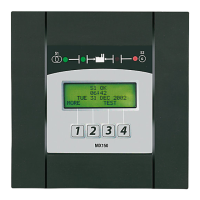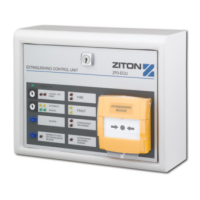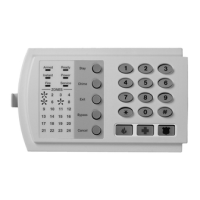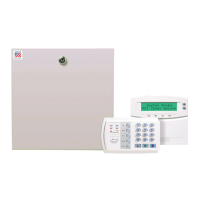ZP3 Fire Control Panel User Guide
Fault alarms
A fault alarm displays on the panel as described in Table 5. The actions carried out upon receipt
of a fault alarm depend upon the procedures at the organization where the system is installed.
The following are generic guidelines only.
Table 5: Fault alarms - annunciation and alarm
Description Remarks
Common "Fault" LED's Illuminated
Text display Zone screen showing details of zone or category with the fault, and a general
description of the fault.
Panel Buzzer Sounding continuously.
Building Sounders Not sounding. Fault alarms are treated as a general alarm.
Auxiliary Functions The functions configured to operate are active, such as advising the remote manned
centre, calling maintenance staff, etc.
Status Indicators Illuminated to indicate the area of fault. In addition, the LED's indicate which
functions have been activated, such as advising the remote manned centre, etc.
Delayed Functions Certain functions programmed to operate as a result of the fault alarm might be
configured as a delayed operation. These could be remote centre alarms, or control
functions. If a function has been triggered to operate after a delay, then the
"delayed" LED on the status indicator illuminates.
Types of fault
The panel continuously monitors both itself and all external wiring and devices for abnormal
conditions. Faults fall into one of three categories (see Table 6):
Table 6: Fault alarms – types of fault
Category Description
Serious Faults A system fault, which takes the complete system out of operation, such as a processor failure,
requires immediate action.
Part-system
Faults
A fault, which takes a small part of the system out of action, needs to be repaired within the
same day. Examples of part-system faults are; a damaged cable, or a mains failure where the
batteries operate the system for the rest of the day.
Operator action
1. Press the Accept button to acknowledge the alarm. This silences the panel buzzer, and
causes the flashing alarm indicators to go steady. Do not press the Reset or Silence Alarms
buttons.
2. Call maintenance personnel to fix the fault. Record the action taken in the logbook.
3. Press the Reset button after the fault has been rectified. The system restores to normal.
Page 18 Revision 11 (05/01/2010)

